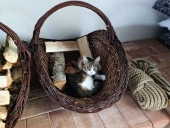Hi all, thank you so much for your great suggestions! I got derailed on the garden beds after discovering that the best sun on the property is entirely on the driveway, so I've been busy building sub-irrigating planters out of tote bins and five gallon buckets.
But I did keep researching the lumber issue, and I recently found a very interesting solution for this problem: "retired" scaffolding lumber. There's a reuse organization, Build It Green! NYC (
http://www.bignyc.org/inventory/item/astoria/scaffolding-lumber) that sells (and donates to local community gardens and non-profits) old scaffolding lumber from the construction projects that are ubiquitous around here. It comes in yellow pine, hemlock, and spruce. It's $1.50 per foot (the boards are generally 10 feet long, 9 inches wide, 2 inches deep, although they'll do cuts for $2 a cut). From everything I've read, scaffolding lumber is untreated and safe to use in gardens. (For NYC dwellers, they have two locations- the Astoria location has much more lumber, but it's pretty remote from the subway. The Gowanus one is one the same block as the Smith and 9th St. stop. Both have onsite parking.)
Another solution is black locust, which would last much longer (possibly decades). But I'd most likely only use it for sub-irrigating planters or something that is definitely portable enough to take with me easily. There seems to be a lot of black locust in the Northeast, and it's considered a fast growing "weed" tree, so it certainly seems like a responsible choice. The only hitch is that because the wood is so hard I think you might need stronger bits and saws to get through it, so I'm thinking that because of the possible time/equipment investment involved I might not want to use it on something that could potentially get left behind whenever we move!












































